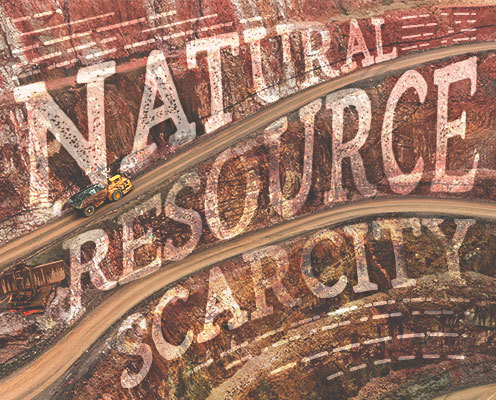
Natural Resources on a Tightrope
Managing dependencies in supply chains
By Dimitra Kalaitzi, Aristides Matopoulos, Michael Bourlakis and Wendy Tate
As economic growth in developing nations accelerates, competition for natural resources is intensifying, leaving the manufacturing industry exposed to a number of challenges, including rising material prices, shortages of minerals (e.g. antimony and zinc) and rare-earth metals (e.g. dysprosium and neodymium), as well as more potentially catastrophic and irreversible resource scarcity (e.g. potable water depletion). Yet, despite the disruptive potential of these challenges, too many organizations are failing to proactively address and adequately prepare for the significant turmoil resource scarcity will have on their supply chains.
In a recently published paper in the International Journal of Operations & Production Management entitled “Supply chain strategies in an era of natural resource scarcity,” we provide insights from six large multinational companies, representing the automotive and aluminum industry, on the implications of natural resource scarcity. Drawing on Resource Dependence Theory, we identified three contingent factors that determine an organization’s dependence on scarce natural resources and looked at specific supply chain strategies to overcome or minimize this dependence.
Before developing any strategy, we posit that companies must first and foremost have a clear understanding of the three contingent factors that determine dependency on these resources.
These factors are:
Importance of the resource (i.e. cost, quantity and functional criticality). Rise in electricity prices affects the price of certain commodities as their production is energy intensive. For example, aluminum companies reported that energy costs are responsible for almost 40 percent of the total aluminum production costs. In 2014 energy prices hit a record high in Brazil, and three smelters closed in total.
Supplier substitutability of the resource (i.e. availability of alternative suppliers and the switching costs). When it comes to aluminum, there are only a few suppliers (e.g. two in Europe and 5-6 globally), and thus companies are dependent on a relatively small number of suppliers.
Discretion over the resource (i.e. the ownership of resources or the ability to access and use resources due to legislation and geopolitical risk). The supply of specific resources such as rare-earth metals becomes less available and governments try to protect domestic resources by imposing export restrictions. For example, China, that has the most rare-earth reserves, restricted exports of rare-earth metals to Japan in September 2010.
When it comes to strategies for managing resource dependencies in the supply chain, we identified two main types: buffering and bridging.
Buffering strategies
- Product and processes (re)configuration: This strategy encompasses the utilization of new technologies or recycling when the cost or the quantity of the resource is high, or the resource is critical and cannot be substituted. For example, one of the automotive manufacturers from our study has redesigned its wires due to price fluctuations of the copper. Specifically, this company made thinner wires, combining aluminum and copper, to minimize the use of copper.
- Supply chain (re)configuration: This approach is demonstrated by the adaptation of the network design and inventory decisions to improve access to scarce resources. In our research, we found that decisions for building new facilities (e.g. plants, collection/acquisition centers, inspection/sorting centers, disposal facilities) are largely driven by the need to access scarce resources and establish closed-loop supply chains to minimize resource usage and waste, increase the recycling rate of resources and thus, minimize purchasing cost as well as the cost of processing of resources.
Bridging strategies
- Transactional: When the resource is more of a commodity, even when only a few suppliers exist, our research shows that instituting long-term contracts that establish supply and price over an extended period, is the preferred strategy. For instance, fixed-term contracts are preferred when dealing with water, gas, and electric power. However, our research indicates that this necessitates frequent-every two-to-three years-contract reviews and may compel contract renegotiations, additional market research, and potential change of supplier, if necessary and feasible.
- Relational: This approach includes partnerships and joint ventures to achieve discretion over the resource. This tack is mainly chosen when supplier options were constrained, and the natural resource was critical for business continuity. For example, one automotive company has a partnership with a supplier of aluminum for closed-loop recycling from its vehicle manufacturing.
- Hierarchy: In these cases, organizations move to retain ownership or control over a resource through acquisition. When suitable suppliers are limited and either price fluctuations or government regulations make the specific resource difficult to access, vertical integration was the preferred strategy among the manufacturing companies that participated in our work. For instance, the big investment in a new cast house was representative of one of the aluminum manufacturer’s strategy to integrate and secure aluminum production through in-house raw materials supply.
Key takeaways
Our research looked at the different strategies that companies could implement in order to manage some of the dependencies in their supply chains with regard to natural resource scarcity. What became clear is that the challenge for many companies is the lack of transparency for certain materials. This is either due to a reluctance among Tier 1 suppliers to share information or a dearth of visibility into the origin of some of the natural resources used for their parts (e.g. for rare-earth metals). It is our analysis that organizations should prioritize visibility of scarce materials from lower-tier suppliers, especially if critical components are involved.
Companies can achieve transparency by establishing close relationships with key suppliers that can empower these players, making them more proactive and reducing cost by determining in which products and what points in the manufacturing process scarce natural resources are most likely to be required and by investing on new tools in which each supplier (Tier 1, Tier 2…Tier N) can provide a comprehensive overview of the flows of the resources in order to understand risk hotspots of the resources (e.g. high resource intensity areas) in particular supply chains.